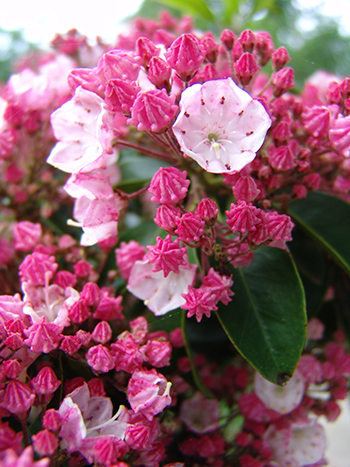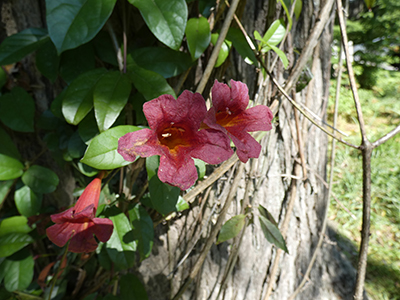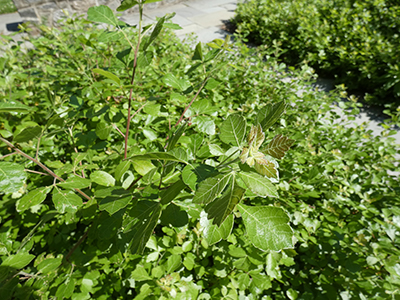
Plants of the Week: May 27
Guest Author: Ben Hitz – summer intern

Kalmia latifolia (Mountain-laurel)
This Eastern U.S. native shrub, found near the Cunningham House parking lot, boasts some of the more interesting flowers in the plant kingdom. These late spring emerging flowers are cup shaped and five- parted with colors ranging from white to dark pink. The stamens of the flower are bent back into pockets in the petals, creating a spring mechanism that flings pollen when a pollinator disturbs the flower. Mountain-laurels grow 5’-15’ tall and wide and feature whorled, evergreen foliage on the tips of its twigs. These ericaceous shrubs grow best in part shade with rich, well drained soil. Photo credit: R. Robert

Bignonia capreolata (crossvine)
This vigorous flowering vine, located on the ginkgo in West Parrish Circle, uses adhesive discs on the tips of branched tendrils to climb structures. Attractive, bifoliate compound leaves stay evergreen in the South, will turn a deep purple and then drop in the northern parts of its range. In the Bignoniaceae, or trumpet creeper family, the vine has orangish-red trumpet shaped flowers that appear in spring and transition into seed pods in the summer. Its common name, crossvine, is a reference to a cross-shaped marking that is revealed when a cross section of the plant is made. B. capreolata is easily grown in average, well drained soil in part sun to full shade. Photo credit: B. Hitz

Rhus aromatica ‘Gro Low’ (fragrant sumac)
Rhus aromatica, found in the Isabelle Cosby Courtyard, is an eastern North America native shrub. Trifoliate, glossy green leaves resemble a closely related cousin, poison ivy, yet Rhus aromatica does not cause a skin rash. The foliage actually emits a fresh cut grass aroma when bruised, hence its common name, fragrant sumac.
Small, non showy yellow flowers bloom on the twig tips in the early spring before the foliage emerges. These flowers give way to hairy red berries in the summer that are attractive to wildlife. R. aromatica is an excellent native ground cover. It tolerates poor soils and can be used to stabilize erosion prone embankments. The ‘Gro Low’ cultivar is a dense, low growing variety that spreads vigorously via root suckers. Photo credit: B. Hitz





James F McLaughlin
Posted at 18:26h, 08 AprilWhere’s a good place to get a mountain laurel nearby?
Mary Tipping
Posted at 08:35h, 09 AprilCheck with Mostardi Nursery, Kirkpatrick Nurseries, Wedgewood Gardens, or Gateway Garden Center.
Regards,
Mary Tipping,
Curator
Scott Arboretum of Swarthmore College